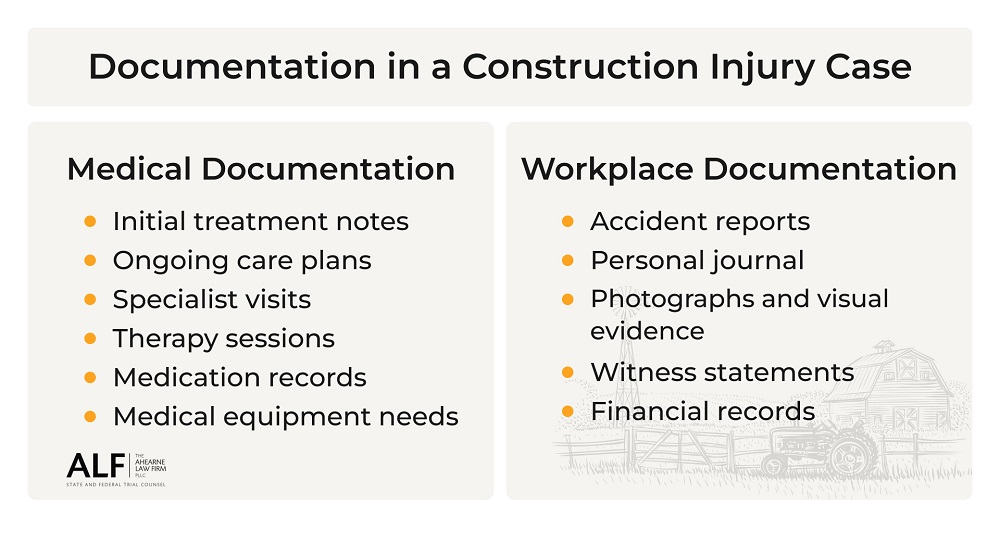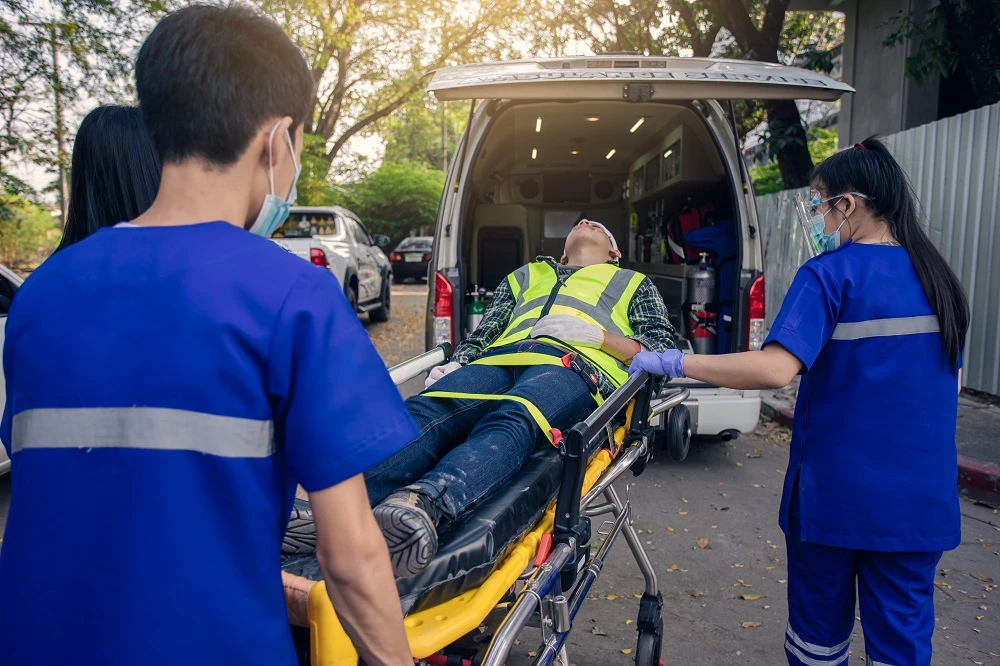Every day across New York’s skyline, construction workers brave heights, heavy machinery, and dangerous conditions to build our city’s future. While construction sites buzz with productivity, they also rank among the riskiest workplaces in America. The battle between progress and worker safety plays out daily, with construction accidents leaving lasting marks on workers’ lives.
At The Ahearne Law Firm, PLLC, our New York construction accident lawyers have spent years fighting for construction workers’ rights after workplace injuries change their lives. Our experience handling construction accident cases has shown us that proper documentation often makes the difference between full compensation and denied claims. We’ve assembled this guide to help workers protect their rights from the moment an injury occurs.
New York Construction Site Injury Statistics
On construction sites across the five boroughs, from Manhattan’s soaring towers to Brooklyn’s residential projects, workers face constant risks of injury. The NYC Department of Buildings (DOB) documented 554 serious work-related injuries and 11 fatal occupational injuries in 2022, highlighting how common these incidents are in construction. These statistics only represent reported incidents. Many minor injuries and near-misses go unreported, suggesting the actual toll on a construction worker could be significantly higher.
Most Common Construction Site Injuries in New York
Construction workers face numerous hazards daily that can result in serious work-related injuries. OSHA’s “Fatal Four” — the four leading causes of construction accidents — include falls from heights, struck-by incidents, electrocutions, and caught-in/between accidents.
These common accidents lead to various injuries, ranging from minor to catastrophic. Let’s examine each type of injury and its impact on construction workers’ lives:
- Head injuries: Concussions, traumatic brain injuries (TBI), skull fractures, facial injuries.
- Back injuries: Herniated discs, spinal cord trauma, lumbar sprains and strains.
- Bone fractures: Compound fractures, stress fractures, crushing injuries.
- Joint injuries: Rotator cuff tears, knee ligament damage, elbow and wrist complications.
- Burn injuries: Electrical burns, chemical burns, thermal burns, flash burns.
- Respiratory conditions: Silica dust exposure, asbestos exposure, chemical pneumonia.
- Eye injuries: Impact injuries, chemical exposures, welding flashes.
- Hearing loss: Noise-induced hearing damage.
Despite advances in the use of personal protective equipment (PPE) and safety protocols, equipment accidents and fall accidents continue to pose serious threats to construction workers’ health and safety.
Documentation for Construction Site Injuries in New York
Construction site injuries require detailed records from the moment they occur through the entire recovery process. In New York’s construction industry, where workplace injuries happen daily, proper records can make the difference between denied claims and fair compensation.
The Importance of Proper Documentation in Construction Injury Cases in New York
Poor record-keeping leaves injured construction workers vulnerable. Even with severe injuries, claims often face denial without supporting evidence. Medical records tell only part of the story — workers need comprehensive documentation showing how injuries affect their daily lives and ability to work.
Complete documentation helps to:
- Link workplace conditions to specific injuries.
- Prove needs for ongoing medical treatment.
- Show lost wages and reduced earning capacity.
- Establish liability of responsible parties.
- Secure appropriate compensation.
Essential Construction Injury Documentation

Strong injury cases require comprehensive records covering multiple aspects.
Medical records:
- Initial treatment notes: Obtain copies of the medical records from the first responders, emergency room, urgent care, or initial doctor’s visit. These will provide the first detailed account of your injuries, including the nature and severity of your wounds, the initial diagnoses, and the immediate treatment provided. These records establish a timeline and baseline for your injuries.
- Ongoing care plans: Keep a comprehensive file of all records from follow-up appointments with your primary care physician, specialists like orthopedists or neurologists, physical therapists, and any other healthcare providers involved in your treatment. These records will document the progression of your injuries, the treatments and therapies recommended, and your recovery process over time.
- Specialist visits: Request detailed written reports from any specialists you see, such as orthopedists, neurologists, surgeons, or other experts. Their expert evaluations and diagnoses carry significant weight as evidence, as they can provide in-depth assessments of the extent and long-term implications of your injuries.
- Therapy sessions: Obtain all records from your physical therapy, occupational therapy, or other rehabilitation treatments. These will demonstrate your recovery efforts, the limitations you’ve faced, and your progress (or setbacks) in regaining function and mobility.
- Medication records: Maintain copies of all prescriptions you’ve received, pharmacy receipts for the medications you’ve purchased, and any notes from your healthcare providers about the effects or side effects of the drugs. This documentation helps justify the medical expenses you’ve incurred.
- Medical equipment needs: Keep receipts, invoices, or other records related to any crutches, braces, wheelchairs, or other assistive devices you’ve required due to your injuries. These records can substantiate the additional costs associated with your recovery.

Workplace evidence:
- Accident reports: Obtain copies of any incident reports, accident investigations, or safety logs created by your employer or the construction site management. These records can provide crucial details about the circumstances of the accident and help establish liability.
- Personal journal: Maintain a detailed personal journal documenting the accident, your injuries, the medical treatments you’ve received, and the overall impact on your life. Record daily notes about your physical and emotional state, the limitations you’ve faced, and any out-of-pocket expenses you’ve incurred. This firsthand account can be powerful evidence.
- Photographs and visual evidence: Take clear, high-quality photographs of your injuries, the accident scene, and any relevant equipment or conditions that may have contributed to the incident. Video documentation can also be compelling evidence. These visual records can help recreate the events and demonstrate the hazards present.
- Witness statements: If there were any witnesses to the accident, collect their contact information and request that they provide written statements detailing what they observed. Witness accounts can corroborate your version of events and strengthen your case.
- Financial records: Keep meticulous records of all medical bills, receipts for medications and medical equipment, and documentation of any lost wages or income due to your injuries. These financial records are essential for calculating the full extent of your damages and ensuring you receive adequate compensation.

OSHA Construction Injury Reporting in New York
Reporting construction accidents to the Occupational Safety and Health Administration (OSHA) is a critical component of the documentation process. OSHA has established strict regulations that mandate specific reporting requirements for construction companies and employers.
Legal Requirements for Reporting Construction Accidents
Under OSHA regulations, employers in the construction industry are required to report certain types of work-related injuries and fatalities within specified timeframes. There are two sorts of such reporting.
Immediate reporting:
- Fatalities: Employers must report any work-related fatalities within 8 hours.
- Severe injuries: Employers must report any work-related in-patient hospitalizations, amputations, or eye losses within 24 hours.
Standard reporting:
- Injuries requiring medical treatment: Employers must record any work-related injuries or illnesses that result in medical treatment beyond first aid within 7 days.
- Work restrictions or transfers: Employers must record any work-related injuries or illnesses that cause an employee to be restricted from their normal job duties or transferred to another job within 7 days.
- Loss of consciousness: Employers must record any work-related injuries or illnesses that result in loss of consciousness within 7 days.
- Diagnosed occupational illnesses: Employers must record any work-related cases of diagnosed cancer, chronic irreversible diseases, fractured or cracked bones, and punctured eardrums within 7 days.

The OSHA Reporting Process
When a reportable construction accident occurs, employers have several options for notifying OSHA:
- Contacting the nearest OSHA area office.
- Calling the OSHA 24-hour hotline at 1-800-321-OSHA (1-800-321-6742).
- Submitting an online form through the OSHA website.
Regardless of the reporting method used, employers must provide accurate and detailed information, including the business name, name(s) of affected employee(s), location and time of the incident, description of the injury or illness, and contact person and phone number.
Legal Guidance in Construction Accident Documentation
Beyond basic documentation, construction injury cases need strategic organization of evidence that demonstrates not just how an injury occurred, but its full impact on a worker’s life. Many injured workers lose valuable evidence in the early days after an accident. Without proper guidance, they might miss documenting key details that could significantly strengthen their construction accident claim and lawsuit.
An experienced construction accident attorney knows exactly what evidence to gather, how to preserve it properly, and how to present it effectively. Early legal guidance helps ensure no valuable evidence is lost and that all documentation meets legal standards for admissibility.
